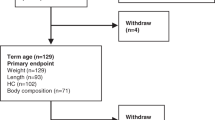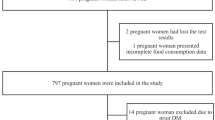Abstract
Objective:
We compared feeding practices between infants of high ponderal index (PI) at birth (PI above the 90th percentile) and normal PI at birth (PI between 10th and 90th percentiles), and examined how birth size and infant feeding practices were related to body mass index (BMI) at 12 months.
Design:
In a cohort of 3000 infants invited to participate in a national Norwegian dietary survey, 1825 participated both at 6 and 12 months of age, and the present study included those born full term and with a PI (weight/length3) at birth ≥10th percentile (n=1441). Data on feeding practices were collected by food-frequency questionnaires, and anthropometrical data were measured by health-care personnel.
Results:
A lower proportion of infants born with high PI were exclusively breastfed for at least 4 months compared with infants born with normal PI (37 and 47%, respectively; P=0.03). Earlier introduction of solid foods and higher consumption of some foods were also observed among infants of high PI. In a multivariate analysis, adjusted mean BMI (kg/m2) at 12 months was higher for infants of high PI at birth than for infants of normal PI (17.6 and 17.0, respectively; P<0.001) and higher for infants exclusively breastfed <3 months than for infants exclusively breastfed ≥3 months (17.5 and 17.2, respectively; P=0.001).
Conclusions:
High PI at birth was associated with a shorter duration of exclusive breastfeeding. Furthermore, high PI at birth and short-term exclusive breastfeeding were both associated with higher BMI at 12 months.
Sponsorship:
The National Council on Nutrition and Physical Activity (now part of the Directorate for Health and Social Affairs), the Norwegian Food Control Authorities (now part of the Norwegian Food Safety Authority) and the Research Council of Norway.
This is a preview of subscription content, access via your institution
Access options
Subscribe to this journal
Receive 12 print issues and online access
$259.00 per year
only $21.58 per issue
Buy this article
- Purchase on Springer Link
- Instant access to full article PDF
Prices may be subject to local taxes which are calculated during checkout
Similar content being viewed by others
References
Andersen LF, Lande B, Arsky GH & Trygg K (2003): Validation of a semi-quantitative food-frequency questionnaire used among 12-month-old Norwegian infants. Eur. J. Clin. Nutr. 57, 881–888.
Atladottir H & Thorsdottir I (2000): Energy intake and growth of infants in Iceland—a population with high frequency of breast-feeding and high birth weight. Eur. J. Clin. Nutr. 54, 695–701.
Baeten JM, Bukusi EA & Lambe M (2001): Pregnancy complications and outcomes among overweight and obese nulliparous women. Am. J. Public Health 91, 436–440.
Bergmann KE, Bergmann RL, von Kries R, Böhm O, Richter R, Dudenhausen JW & Wahn U (2003): Early determinants of childhood overweight and adiposity in a birth cohort study: role of breast-feeding. Int. J. Obes. Relat. Metab. Disord. 27, 162–172.
Davies DP (1980): Size at birth and growth in the first year of life of babies who are overweight and underweight at birth. Proc. Nutr. Soc. 39, 25–33.
Dewey KG (1998): Growth characteristics of breast-fed compared to formula-fed infants. Biol. Neonate 74, 94–105.
Dewey KG (2003): Is breast-feeding protective against child obesity? J. Hum. Lact. 19, 9–18.
Dewey KG, Heinig MJ, Nommsen LA, Peerson JM & Lönnerdal B (1992): Growth of breast-fed and formula-fed infants from 0 to 18 mo: the DARLING Study. Pediatrics 89, 1035–1041.
Dewey KG, Heinig MJ, Nommsen LA, Peerson JM & Lönnerdal B (1993): Breast-fed infants are leaner than formula-fed infants at 1 y of age: the DARLING Study. Am. J. Clin. Nutr. 57, 140–145.
Fuentes RM, Notkola I-L, Shmeikka S, Tuomilehto J & Nissinen A (2003): Tracking of body mass index during childhood: a 15-year prospective population-based family study in eastern Finland. Int. J. Obes. Relat. Metab. Disord. 27, 716–721.
Galtier-Dereure F, Boegner C & Bringer J (2000): Obesity and pregnancy: complications and cost. Am. J. Clin. Nutr. 71 (Suppl), 1242S–1248S.
Grummer-Strawn LM & Mei Z (2004): Does breastfeeding protect against pediatric overweight?Analysis of longitudinal data from the Centers for Disease Control and Prevention Pediatric Nutrition Surveillance System. Pediatrics 113, e81–e86. URL:http://www.pediatrics.org/cgi/content/full/113/2/e81.
He Q, Ding ZY, Fong DYT & Karlberg J (2000): Risk factors of obesity in preschool children in China: a population-based case–control study. Int. J. Obes. Relat. Metab. Disord. 24, 1528–1536.
Hediger ML, Overpeck MD, Maurer KR, Kuczmarski RJ, McGlynn A & Davis WW (1998): Growth of infants and young children born small or large for gestational age. Findings from the Third National Health and Nutrition Examination Survey. Arch. Pediatr. Adolesc. Med. 152, 1225–1231.
Jacobsen BK, Njølstad I, Thune I, Wilsgaard T, Løchen M-L & Schirmer H (2001): Increase in weight in all birth cohorts in a general population. The Tromsø Study, 1974–1994. Arch. Intern. Med. 61, 466–472.
Knudtzon J, Waaler PE, Skjærven R, Solberg LK & Steen J (1988): Nye norske percentilkurver for høyde, vekt og hodeomkrets for alderen 0–17 år. (New Norwegian percentile curves for height, weight, and head circumference for ages 0–17 y). Tidsskr. Nor. Lægeforen. 108, 2125–2135 (in Norwegian).
Kramer MS, Barr RG, Leduc DG, Boisjoly C, McVey-White L & Pless IB (1985): Determinants of weight and adiposity in the first year of life. J. Pediatr. 106, 10–14.
Lande B, Andersen LF, Bærug A, Trygg KU, Lund-Larsen K, Veierød MB & Bjørneboe G-EAa (2003): Infant feeding practices and associated factors in the first six months of life: The Norwegian Infant Nutrition Survey. Acta Paediatr. 92, 152–161.
Lande B, Andersen LF, Veierød MB, Bærug A, Johansson L, Trygg KU & Bjørneboe G-EAa (2004): Breastfeeding at 12 months of age and dietary habits among breast-fed and non-breast-fed infants. Public Health Nutr. 7, 495–503.
Li L, Parsons TJ & Power C (2003): Breast feeding and obesity in childhood: cross sectional study. BMJ 327, 904–905.
Ludwig DS, Peterson KE & Gortmaker SL (2001): Relation between consumption of sugar-sweetened drinks and childhood obesity: a prospective, observational analysis. Lancet 357, 505–508.
Martorell R, Aryeh D, Stein D & Schroeder DG (2001): Early nutrition and later adiposity. J. Nutr. 131 (Suppl), S874–S880.
Medisinsk fødselsregister (Medical Birth Registry of Norway). Internet:http://www.uib.no/mfr/statistikk.html(accessed 6 July 2004) (in Norwegian).
Meeuwisse G & Olausson PO (1998): Økad födelsevikt i Norden. Allt större andel nyfödda väger över fyra kilo. (Increased birth weight in the Nordic countries. An increasing proportion of newborns weighing more than four kilos). Läkartidningen 95, 5488–5492 (in Swedish).
Nielsen GA, Thomsen BL & Michaelsen KF (1998): Influence of breastfeeding and complementary food on growth between 5 and 10 months. Acta Paediatr. 87, 911–917.
Ong KK, Preece MA, Emmett PM, Ahmed ML & Dunger DB (2002): Size at birth and early childhood growth in relation to maternal smoking, parity and infant breast-feeding: longitudinal birth cohort study and analysis. Pediatr. Res. 52, 863–867.
Pietiläinen KH, Kaprio J, Räsänen M, Winter T, Rissanen A & Rose RJ (2001): Tracking of body size from birth to late adolescence: contributions of birth length, birth weight, duration of gestation, parent's body size, and twinship. Am. J. Epidemiol. 154, 21–29.
Rasmussen KM, Hilson JA & Kjolhede CL (2001): Obesity may impair lactogenesis ll. J. Nutr. 131 (Suppl), 3009S–3011S.
Rogers I & EURO-BLCS Study Group (2003): The influence of birthweight and intrauterine environment on adiposity and fat distribution in later life. Int. J. Obes. Relat. Metab. Disord. 27, 755–777.
Statens ernæringsråd & Statens næringsmiddeltilsyn (1995): Den store matvaretabellen 1995. (Food Composition Table 1995). Oslo: Universitetsforlaget (in Norwegian).
Swinburn BA, Caterson I, Seidell JC & James WPT (2004): Diet, nutrition and the prevention of excess weight gain and obesity. Public Health Nutr. 7, 123–146.
Tanaka T, Matsuzaki A, Kuromaru R, Kinukawa N, Nose Y, Matsumoto T & Hara T (2001): Association between birthweight and body mass index at 3 years of age. Pediatr. Int. 43, 641–646.
Thorsdottir I, Gunnarsdottir I & Palsson G (2003): Association of birth weight and breast-feeding to coronary heart disease risk factors at the age of 6 years. Nutr. Metab. Cardiovasc. Dis. 13, 267–272.
World Health Organization (WHO) (1999): Indicators for Assessing Breastfeeding Practices, Unpublished Document WHO/CDD/SER 91.14 1999 Available on request from the Nutrition Programme, World Health Organization, Geneva.
World Health Organization (WHO) (2003): Diet, nutrition and the prevention of chronic diseases. Report of a Joint WHO/FAO Expert Consultation. Geneva: World Health Organization WHO Technical Report Series; 916.
Acknowledgements
We thank Kari Lund-Larsen at the Norwegian Food Safety Authority for her contribution in developing the survey design and the SFFQ and Elin Bjørge Løken at the Department of Nutrition, University of Oslo for her contribution in establishing the final food database for this survey. This work was supported by a grant from the Research Council of Norway.
Author information
Authors and Affiliations
Corresponding author
Additional information
Guarantor: B Lande.
Contributors: BL carried out the data analyses and wrote the manuscript, MBV, LFA, TH and LJ assisted and provided advice during all the stages of the work, MBV provided advice for the statistical analyses, BL, LFA, AB, KUT and G-EB were involved in the design and implementation of the survey. All authors contributed in the discussion and interpretation of the results, and in drafting and editing the manuscript. No conflicts of interest are declared.
Rights and permissions
About this article
Cite this article
Lande, B., Andersen, L., Henriksen, T. et al. Relations between high ponderal index at birth, feeding practices and body mass index in infancy. Eur J Clin Nutr 59, 1241–1249 (2005). https://doi.org/10.1038/sj.ejcn.1602235
Received:
Revised:
Accepted:
Published:
Issue Date:
DOI: https://doi.org/10.1038/sj.ejcn.1602235
Keywords
This article is cited by
-
Effect of birth size and proportionality on BMI and skinfold thickness in early adolescence: prospective birth cohort study
European Journal of Clinical Nutrition (2009)



